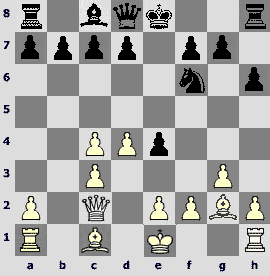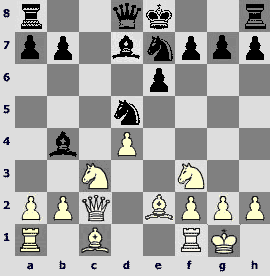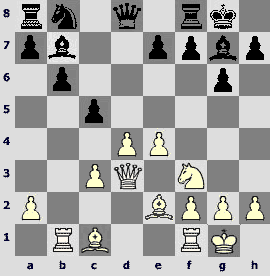21.08.2006
V.Yemelin. Not expanding the track
In my opinion, the recent Dortmund tournament cannot boast about any global theoretical revelations. Crammers of the whole world can relax. Nevertheless, almost any game of the elite brings up a small opening finesse, and it is quite interesting to observe top grandmasters creating problems to each other outside the main theoretical roads. This article should be considered as a modest addition to my previously published article about the Dortmund.
The A index was used just once.
B.Jobava (2651) – L.Aronian (2761) (A29)
1.c4 ¤f6 2.¤c3 e5 3.¤f3 ¤c6 4.g3 ¤d4 5.Ґg2 ¤xf3+ 6.Ґxf3 Ґb4 7.d4.A rare variation, 7.Јb3 is the normal move. Aronian turns out well-prepared for such course of events.
7...Ґxc3+.Black can postpone this exchange, although the point of it is not exactly clear: 7...e4 8.Ґg2 0-0 9.0-0 (Black does not prevent the pin 9.Ґg5, and White does not rush pinning) 9...Ґxc3 10.bxc3 ¦e8 11.Ґg5 (finally; had Black prevented this pin, White could try trapping him in the following way: 11.Јc2 h6 12.f3 exf3 13.¦xf3 d6 14.Ґxh6 gxh6 15.¦af1± with powerful attack, which became decisive after15...¤e4 16.¦xf7 Јg5 17.Јxe4! Conquest-Smith, Hamilton 1999) 11...h6 12.Ґxf6 Јxf6 13.f3 exf3 (13...e3І) 14.Ґxf3 Јg5 15.Ґd5 ¦e7 16.Јd3 c6 17.¦f5 with clear initiative for White, Kamsky-Campora, Buenos Aires 1993).
8.bxc3 e4 9.Ґg2 h6 10.Јc2

10...0-0. After a natural 10...Јe7 White should reject creative 11.g4?! d6 12.g5 hxg5 13.Ґxg5 Ґf5 14.¦b1 b6„ Makarychev-Vyzhmanavin, Moscow 1987, in favor of purely positional 11.a4 d6 12.Ґa3.
11.Ґxe4 ¤xe4 12.Јxe4 ¦e8 13.Јf3 Јe7. Aronian convincingly improves the Black`s play in Korchnoi-Bareev, Tilburg 1991, which continued 13...¦b8 14.0-0 b6 15.¦e1 Ґa6 16.Јg4± with clear advantage for White.
14.Ґe3

Bareev assesses this position in the Informant as ±. However, Levon`s opinion is different...
14...¦b8 15.a4. The pawn could be kept by 15.0-0 b6 16.¦ab1 followed by c4-c5 somewhere.
15...b6 16.a5 Ґa6 17.axb6 ¦xb6 18.0-0 Ґxc4 19.¦xa7 ¦f6 20.Јg4 ¦g6 21.Јf3. White takes the move repetition. There is no point in keeping the pawn by 21.Јf4 d6 22.¦e1 Јe6 – Black has decent compensation. 21.Јh5 Јe4 22.¦xc7 Ґd5 23.Јf3 Јe6 24.Јh5 Јe4= also leads to a draw.
21...¦f6 1/2-1/2
B00-B99
M.Adams (2732) – B.Jobava (2651) (B14)
1.e4 c6 2.d4 d5 3.exd5 cxd5 4.c4 ¤f6 5.¤c3 e6 6.¤f3 Ґb4 7.cxd5 ¤xd5 8.Јc2 ¤c6 9.Ґe2 ¤ce7. This plan of radical strengthening of the d5-square apepars to me the strongest reply to 8.Јc2 in the Panov Attack.
10.0-0. Adams already faced this plan:10.a3 Ґd6 11.¤e4 (11.Ґg5 0-0 12.0-0 h6 13.Ґh4 Јc7 14.Ґd3 ¤xc3 15.bxc3 ¤f5 16.Ґg3 ¤xg3 17.hxg3 b6 Adams-Riazantsev, Bastia2005 m4) 11...0-0 12.Ґd3 h6 13.0-0 b6 14.Ґe3 Ґb7 15.Јd2 ¤f5 (Adams-Riazantsev, Bastia 2005 m1). In both games it was White who had problems.
10...Ґd7! An important nuance – the bishop comes to c6 before castling!

11.¤xd5. Adams tests a new approach. Earlier White started with11.¤e5 0-0 (Ovechkin rightly consider 11...¦c8 12.Ґd2 0-0 equalizing) 12.Јb3 Ґc6 13.Ґg5 (Ulybin-Ovechkin, Krasnoyarsk 2003). Acorrect 13...Јb6 equalizeseasily. The following game is considered the most advantageous for White (but it nevertheless ended in a draw): 11.¤e4 Ґc6 12.¤e5 Ґd6 13.Ґd2 Јc7 14.¤xd6+ Јxd6 15.Јc5 Јxc5 16.dxc5І, A.Sokolov-Izoria, Greece 2005. Jobava had good memories of 11.a3 Ґd6 12.¤e4 Ґc6 13.¤xd6+ (13.¤e5 h6 14.b4 a6 15.¤xc6 ¤xc6 16.Ґb2 ¦c8, and Black is fine, Kobalia-Ovechkin, Moscow 1999) 13...Јxd6 14.¤e5 0-0 15.Ґd3 ¤f6 16.Ґe3 ¦ac8 17.Јc5 Јd5 18.f3 ¤g6, Nisipeanu-Jobava, Scanderborg 2005.
11...¤xd5 12.¤e5 Ґd6. After an immediate 12...0-0 White starts bothering Black on the kingside: 13.Ґd3 h6 14.Јe2.
13.Јb3 Јb6 14.Јf3 Ґxe5 15.dxe5 0-0 16.Јg4 ¤e7

White`s two bishop advantage is compensated by more convenient deployment of Black`s pieces. Forcing the game leads nowhere:
17.Ґe3 Јxb2 18.¦ab1 Јxa2 19.¦xb7. The pin fails to scare Black:19.Ґc5 ¦fe8 20.Ґxe7 ¦xe7 21.¦xb7 (21.Ґd3 ¦ae8 22.Јe4 (22.Јh4 g6 23.¦xb7 Јd5 xe5) 22...g6 23.¦xb7 Ґc8=) 21...¦ae8 22.¦c1 Јa4 (22...Ґa4 23.¦xe7 ¦xe7 24.Јb4ќ) 23.h3 Јxg4 24.hxg4 Ґa4 25.¦b4 Ґd7, and there is no way to exploit Black`s rather hampered position: 26.Ґa6 f6=.
19...¤g6 20.¦xd7 ¤xe5 21.¦d2 Јxd2 22.Ґxd2 ¤xg4 23.Ґxg4 a5. A draw is agreed. Black does not lose the a-pawn quickly, but he cannot make any progress either, for instance, 24.Ґf3 ¦a6 (24...¦a7 25.Ґe3) 25.Ґe2 ¦a7 26.Ґe3 ¦b7 27.¦a1 ¦b2 28.ўf1 ¦fb8 29.Ґd3 etc. 1/2-1/2
P.Leko (2738) – B.Gelfand (2729) (B80)
1.e4 c5 2.¤f3 d6 3.d4 cxd4 4.¤xd4 ¤f6 5.¤c3 a6 6.f3 e6 7.Ґe3 b5 8.Јd2 b4 9.¤a4 ¤bd7 10.Ґc4!? ‘Almost a novelty` in the Najdorf on the move 10!

10...Јc7. The database gives just one reference: 10...Јa5 11.b3 Ґb7 12.a3 d5 (Evaldt-Ftacnik, Hamburg 2005). The position is unclear and should be analyzed. It is a pity it wasn`t Leko who played White.
11.Ґb3 Ґb7 12.c3 One cannot do without this move any longer: 12.0-0 d5.
12...bxc3. A computer-style optimistic 12...d5 does not look right: 13.cxb4 dxe4 14.¦c1 Јb8 15.¤c5 with the initiative.
13.¤xc3 Ґe7

14.0-0. I cannot believe it is not tempting to get three pawns for a piece, leaving the enemy king in the center! One should have done it at once: 14.Ґxe6!? fxe6 15.¤xe6 Јc4 16.¤xg7+ ўf7 17.¤f5 d5 (after 17...¤e5 18.Јxd6 Ґxd6 19.¤xd6+ ўe6 20.¤xc4 ¤xc4 21.Ґd4!± White should be better; after 17...Јe6 18.0-0 a tense position arises, but I rate the White`s chances higher) 18.¦c1 with a good game. The sacrifice also looks good after 14.¦c1 ¦c8, which can favor White in some lines: 15.Ґxe6 fxe6 16.¤xe6, etc.
14...0-0 15.¦ac1 Јb8 16.¦c2. A logical plan. One can also try an immediate 16.a3.
16...¦c8 17.¦fc1 Ґd8 17...¤e5 is refuted tactically: 18.¤xe6 fxe6 19.Ґxe6+ ўf8 20.Ґxc8 Ґxc8 21.¤d5ќ … ¤b6.
18.ўh1 Ґa5. Once again 18...¤e5 is not good: 19.¤xe6 fxe6 20.Ґxe6+ ўh8 21.Ґxc8 Ґxc8 22.¤b5±, but Black has no intention of playing ¤e5. Gelfand finds a direct way to simplifications.
19.Јe2 ¦c7 (19...Ґxc3 is possible here, too) 20.a3

20...Ґxc3! 21.¦xc3 ¦xc3 22.¦xc3 d5=. Black has solved all the problems.
23.exd5 ¤xd5 24.Ґxd5 1/2-1/2
A theoretically important game Naiditsch-Gelfand is commented in my main Dortmund article.
С00-С99
There is only one more or less interesting game – Svidler-Kramnik. Of course, another annihilation of life in the Petroff is not very exciting, but it is notable how confidently Black drove his ship to the peaceful harbor.
P.Svidler (2742) – V.Kramnik (2743) (C42)
1.e4 e5 2.¤f3 ¤f6 3.¤xe5 d6 4.¤f3 ¤xe4 5.d4 d5 6.Ґd3 ¤c6 7.0-0 Ґe7 8.c4 ¤b4 9.Ґe2 0-0 10.¤c3 Ґf5 11.a3 ¤xc3 12.bxc3 ¤c6 13.¦e1 ¦e8 14.cxd5 Јxd5 15.Ґf4 ¦ac8 16.Ґd3 Јd7 17.¦b1 Ґxd3 18.Јxd3 b6 19.d5 Ґf6 20.c4

This is all book. After 20...h6 21.h3 ¤e7 22.¤e5 Ґxe5 23.¦xe5 ¤g6 24.¦xe8+ ¦xe8 25.Ґg3 Јe7 26.ўh1 White has a minimal pressure. An attempt of 23.Ґxe5 was unsuccessful: 23...¤f5 24.Ґb2 f6 25.Ґc3 ¤d6 (Leko-Bacrot, Linares 2006), and Black easily held the position.
20...¤e7 – it is not a novelty, but a clear indication that Kramnik considers including h3 and h6 favoring White. Now weakness of the back rank is disturbing for White.
21.¤e5. Previously played 21.Ґe5 Ґxe5 (less convincing is 21...Јf5 22.Јxf5 ¤xf5 23.Ґxc7 Ґe7 24.Ґg3 f6 Sebag-Roussel Roozmon, 2004) 22.¤xe5 Јd6 23.Јf3 f6 24.¤g4 ¤g6 25.a4 Јf4 lead to a peaceful conclusion in Jurkovic-Jovanovic, Rieka 2005.
21...Ґxe5 22.Ґxe5 f6 23.Ґf4 ¤f5 24.c5 bxc5 25.Јc4 g5!?

The White`s king has no luft, unlike his counterpart. It is difficult to avoid the forced line that followed in the game.
26.Ґd2 ¤d6 27.Јxc5 ¤e4 28.Јa5 c6 29.Ґe3 cxd5 30.Јxa7 Јxa7 31.Ґxa7 ¤c3 32.¦xe8+ ¦xe8 33.¦b8 ¦xb8 34.Ґxb8 d4 35.ўf1 ўf7 36.Ґa7 (36.ўe1 ўe6) 36...d3 37.ўe1 d2+ 38.ўxd2 ¤b1+ 39.ўd3 1/2-1/2
D00-D99
The games played under this index were intriguing. Recently we witnessed Svidler`s accident in the Grünfeld, after which he had to change ‘cars`, shifting to other openings. Now it seems Peter made all necessary body works, although he still had to suffer some unpleasant minutes in the pet opening.
L.Aronian (2761) – P.Svidler (2742) (D80)
1.d4 ¤f6 2.c4 g6 3.¤c3 d5 4.Ґg5 ¤e4 5.Ґh4 ¤xc3 6.bxc3 dxc4 7.e3

7...Ґe6. Svidler continued 7...Јd5 against Jobava in the Round 1, but after 8.Ґe2! (an important move, preventing b7-b5) 8...Ґg7 (8...Јa5 9.Јc1 Ґe6 10.¤f3 ¤d7 11.0-0 ¤b6 12.e4 f6 led to a sharp game in Gostisa-Kozul, Portoroz 1994) 9.¤f3 ¤d7 10.0-0 ¤b6 11.a4 a5 12.¤d2 White has the initiative.
Now Peter selects a standard move, but after 8.Јb1 goes off the track again: 8...Јd5 9.¤f3 ¤d7. Curiously, Kozul`s setup was effectively used in Atalik-Predojevic, Sarajevo 2004: 9...Јa5 10.Јb2 ¤d7 11.Ґe2 ¤b6 12.0-0 ¤a4 13.Јxb7 Ґd5 14.Јb1 ¤xc3 15.Јe1 Ґg7 16.e4 ¤xe2+ 17.Јxe2 Ґe6 with better chances for Black, who used the Јb1-b2 maneuver to his favor. Svidler, however, looks unimpressed by this scenario, and he probably has a good reason. Nevertheless, he fails to solve the opening problems completely.
10.Ґe2 Ґf5 11.Јb2 Ґg7 12.0-0 e5 13.Јb4 (on 13.¤d2 the most solid reaction is 13...Ґd3) 13...c5 14.Јxc4 Јxc4 15.Ґxc4

Black had a fine way of obtaining an adequate counterplay, showed by Shipov:15...exd4 16.exd4 0-0 17.Ґd5 ¦ab8 18.Ґg3 ¤b6 19.Ґxb8 ¦xb8 20.Ґb3 (20.c4 cxd4) 20...c4 21.Ґd1 ¤d5. After 15...¦c8 16.Ґd5 White has a certain advantage. Both games are annotated in my Dortmund article.
Svidler successfully defended in his favorite variation with b7-b6:
B.Gelfand (2729) – P.Svidler (2742) (D85)
1.d4 ¤f6 2.c4 g6 3.¤c3 d5 4.cxd5 ¤xd5 5.e4 ¤xc3 6.bxc3 Ґg7 7.¤f3 c5 8.¦b1 0-0 9.Ґe2 b6. A less popular move than 9...cxd4, but it seems solid enough at present.
10.0-0 Ґb7 11.Јd3

11...e6. Another game of the same players continued 11...Ґa6 12.Јe3 Јd7 13.d5!? Ґxe2 14.Јxe2 Ґxc3 (Gelfand-Svidler, Monte Carlo 2005), and Peter proved that the White`s attack is not deadly. Peter also played 11...Јc7 12.d5 (12.Ґg5 may lead to the examined game: 12...¤d7 13.Јe3 e6) 12...¤d7 13.Јc2 ¦ad8 14.Ґg5 Ґf6 15.Ґh6 Ґg7 16.Ґxg7 ўxg7 17.a4 e6! 18.dxe6 ¤f6 19.¤g5 h6, and tactical complications lead to simplifications and draw, Bacrot-Svidler, Sofia 2006. It is difficult for me to explain the choice in the text.
12.Ґg5. Peter suffered after 12.h4 ¤d7 13.Ґg5 Јc7 14.h5, Agrest-Svidler, France 2005. Is there an improvement? No doubt!
12...Јc7 13.Јe3 ¤d7 14.e5 ¦ae8. Of course, Black prepares the f7-f6 break, opening his dark-squared bishop and brining the knight closer to a blockade square d5. The weakness on e6 will be compensated by active pieces. After 15.Ґb5 Ґc6 16.Ґxc6 Јxc6 17.h4 f6 18.exf6 ¤xf6 19.¤e5 Јc7 20.¦be1 ¤d5 21.Јg3 ¦f5, Black has no grounds for anxiety, Halkias-Eljanov, Ohrid 2001.
The move 15.¤d2 is given in Krasenkow`s comments to Moiseenko-Eljanov, Kharkov 2001.

Naturally, Black does not allow the knight to d6: 15...f6! Anaccuratemoveorder! After 15...cxd4 16.cxd4 f6 17.¦bc1 Јd8 the Black`s queen is forced to stay on d8, and the f6-knight is pinned.
16.exf6 cxd4! 17.cxd4 ¤xf6 18.¦bc1 Јd7 19.¤c4 ¤d5 20.Јd2 h6! Another important move!
21.Ґe3?! White should have played 21.Ґxh6 Ґxh6 22.Јxh6 ¤f4 23.Ґg4 (23.¦fe1 is also interesting) 23...Јxd4 (bad is 23...Ґxg2? 24.¤e5±) 24.¤e3, although poor location of the White`s queen and Black`s active pieces provide adequate compensation for Black`s damaged pawn structure.
Black got an upper hand after 21...¤xe3 22.fxe3 e5і.
The most interesting games of E00-E99 are Leko-Naiditsch, Kramnik-Naiditsch, Aronian-Naiditsch and Gelfand-Aronian. They are examined in my Dortmund article.
